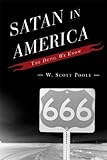Satan in America : the Devil we know / W. Scott Poole.
Material type: TextPublication details: Lanham, Md. : Rowman & Littlefield Publishers, c2009.Description: 1 online resource (xxvi, 243 p., [4] p. of plates )Content type:
TextPublication details: Lanham, Md. : Rowman & Littlefield Publishers, c2009.Description: 1 online resource (xxvi, 243 p., [4] p. of plates )Content type: - 9781442200623
- 1282522132
- 9781282522138
- 1442200626
- Devil -- Social aspects -- United States -- History
- Devil -- Political aspects -- United States -- History
- Devil -- Christianity
- Good and evil -- Social aspects -- United States -- History
- Good and evil -- Political aspects -- United States -- History
- United States -- Religious life and customs
- United States -- Civilization
- National characteristics, American
- Political culture -- United States -- History
- Violence -- United States -- History
- Démon -- Aspect social -- États-Unis -- Histoire
- Démon -- Aspect politique -- États-Unis -- Histoire
- États-Unis -- Civilisation
- Violence -- États-Unis -- Histoire
- SOCIAL SCIENCE -- Sociology of Religion
- Civilization
- Devil -- Christianity
- Devil -- Social aspects
- Good and evil -- Social aspects
- National characteristics, American
- Political culture
- Violence
- United States
- 306.6/35470973 22
- BT982
- online - EBSCO
| Item type | Current library | Call number | URL | Status | Notes | Barcode | |
|---|---|---|---|---|---|---|---|
 eBook
eBook
|
Biblioteca "Angelicum" Pont. Univ. S.Tommaso d'Aquino Nuvola online | online - EBSCO (Browse shelf(Opens below)) | Online access | Not for loan (Accesso limitato) | Accesso per gli utenti autorizzati / Access for authorized users | (ebsco)336958 |
Includes bibliographical references and index.
Preface: "Night stalker" : American exceptionalism and the reality of evil -- "The Devil is come down in great wrath" : the American Satan in the colonial and Revolutionary worlds -- Darkness invisible : the Devil and American revivalism -- The devils of Daniel Webster : satanic cultural politics through World War I -- Casting out devils : American theology and popular religion meets the Devil -- Hellhound on my trail : Satan and twentieth-century American culture -- Lucifer rising : satanic panics and culture wars -- The beast : Satan and the theology of American empire -- Epilogue: Shame the Devil : the problem of evil and American cultural history -- Hunting the Devil : a bibliographic essay.
Description based on print version record and CIP data provided by publisher; resource not viewed.
Satan in America tells the story of America's complicated relationship with the devil. "New light" evangelists of the eighteenth century, enslaved African Americans, demagogic politicians, and modern American film-makers have used the devil to damn their enemies, explain the nature of evil and injustice, mount social crusades, construct a national identity, and express anxiety about matters as diverse as the threat of war to the dangers of deviant sexuality. The idea of the monstrous and the bizarre providing cultural metaphors that interact with historical change is not new. Poole takes a new tack by examining this idea in conjunction with the concerns of American religious history. The book shows that both the range and the scope of American religiousness made theological evil an especially potent symbol. Satan appears repeatedly on the political, religious, and cultural landscape of the United States, a shadow self to the sunny image of American progress and idealism.


